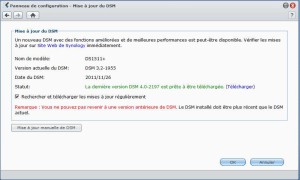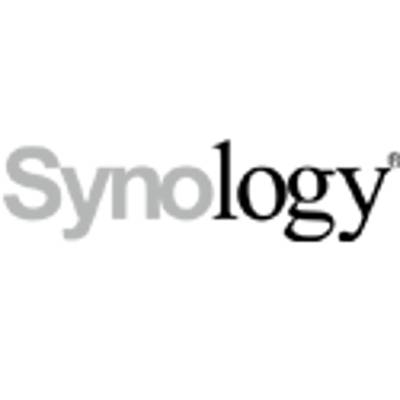La toute dernière version du firmware, le DSM 4.2-3202 de Synology vient de sortir aujourd’hui. Pour notre part, nous apprécions tout particulièrement :
- Le package DNS SERVEUR apparu avec la version beta qui permet de résoudre les dns localement en follower de mon FAI et nous avons en projet d’utiliser le NAS synology en serveur de DNS secondaire. Nous avions fait l’annonce au moment de la sortie de la beta, ici : https://archive.brizawen.com/?p=7567
- Le service de lutte contre les attaques de déni de service (DoS) et la possibilité d’avoir une liste blanche et noire dans fonction auto-block.
- Les modifications et les réparations de volume qui se feront en temps record selon les statistiques de Synology.
Le firmware est téléchargeable chez Synology ici : http://www.synology.com/support/download.php
Mais la meilleure solution est de le télécharger directement via votre interface Synology, Panneau de Configuration, puis Mise à jour du DSM :

Le firmware se téléchargera tout seul et vous n’aurez qu’à l’installer. Attention, les premiers jours le téléchargement cafouille un peu du fait de l’afflux de demandes.
Ci-dessous l’ensemble des nouveautés du Firmware 4.2-3202 en anglais.
- LUN Snapshot & Clone
- LUN Snapshots — This feature allows you to back up and restore multiple versions of LUNs on your DiskStation with minimal impact on performance.
- LUN Clone — Virtual copies of data can now be replicated, allowing you to create identical deployments in different environments or clone an existing LUN snapshot into a new LUN.
- Storage Manager
- Global Hot Spare Disks — Hard disks can now be designated as hot spare disks, which can repair degraded volumes/Disk Groups/iSCSI LUNs by automatically replacing a failed disk.
- S.M.A.R.T. Test Scheduler — You can now perform S.M.A.R.T. tests according to your individual schedule. For example, S.M.A.R.T.tests can be scheduled to run monthly or automatically test all of the disks in your DiskStation.
- Volume Creation and Expansion Enhancements: The speed of volume creation and resizing have been improved up to 14 and 85 times. The chart below is the comparison between DSM 4.1 and DSM 4.2.
|
DSM 4.1 |
DSM 4.2 |
Improvement |
|
|
DS412+ (Create 1TB Volume on a Disk Group) |
314 sec | 23 sec | 14x |
|
DS412+ (Expand 1TB Volume to 2TB on a Disk Group) |
2675 sec | 31 sec | 85x |
- File Services for Windows, Mac OS, and Linux
- SMB2 Protocol Support for Windows File Service — SMB 2 protocol has general improvements to allow for better network utilization.
- Large MTU Support for SMB2. The Large MTU (maximum transmission unit) option allows users to utilize the network capabilities better and achieve faster transferring speed. You can enable this option through a registry key on Windows computers.
- AFP (Apple File Protocol) Performance Enhancements — The speed of file transfers to the DiskStation has improved up to 52%. The following is a comparison between DSM 4.1 and DSM 4.2.
|
DSM 4.1 |
DSM 4.2 |
Improvement |
|
|
DS212+ |
45.2 MB/s | 68.6 MB/s | 51.6% |
- Network Backup, rsync, and Shared Folder sync — The performance of these feature has been generally improved when transferring large numbers of folders and files. The following is a comparison between DSM 4.1 and DSM 4.2.
|
DSM 4.1 |
DSM 4.2 |
Improvement |
|
|
Backup 5000x 1MB files in 1110 folders from DS213+ to DS212 |
32.8 sec | 14.55 sec | 2x |
The time used to run the backup task for the second time.
- File Station
- Single Page of Files — You can now browse up to 1000 files on one single page.
- Thumbnail View — Files and pictures can be displayed as large icons or thumbnails of pictures, if available.
- Hotkeys — The following keyboard shortcuts have been added in order to simplify file management: Select All (Ctrl + A), Cut (Ctrl + X) , Copy (Ctrl + C), Paste (Ctrl + V), Delete (Delete), Rename (F2).
- TFTP & PXE
- TFTP & PXE — You can now set up your DiskStation as a TFTP server, allowing clients to retrieve system boot images via TFTP and implement Pre-Boot Execution Environment (PXE).
- Package Center
- New Design for App Discovery — You can now browse packages by categories or search for specific packages. Screenshots are included to give you a preview of the app before installing them.
- Transaction Platform — Paid and trial versions of packages are available in the new Package Center. Please note, you will need a MyDS Center account in order to purchase paid apps.
- Integrated with MyDS Center Account — You can now review your purchase history on the MyDS Center website.
- 2-step Verification & Account Activity
- 2-step Verification— This feature adds an extra layer of security to your DSM account. Once 2-step verification is enabled, anyone trying to access your account will need a one-time 6-digit code displayed on your smartphone, in addition to your DSM password.
- Account Activity — This feature lets you view your current login session and login history.
- Firewall & Security
- Denial of Service (DoS) Protection — This option allows you to filter out malicious traffic without interrupting safe traffic.
- Customized Block & Allow IP List for Auto Block — You can now manually add IP addresses to your Block and Allow lists to protect your network.
- LDAP/AD Accounts
- More Apps for Enterprise Users — Enterprise users can now enjoy more features of DSM with LDAP or AD accounts. Supported packages includes Cloud Station, Audio Station, Video Station, Mail Server, and Mail Station.
- Task Scheduler
- Automate Tasks — Task Scheduler allows you to schedule and run tasks at pre-defined times. Tasks include running user-defined scripts, cleaning the Recycle Bin on a regular basis, and starting and stopping services, among others.
- Disk Usage Report
- Easily Monitor Storage Usage — The disk usage report feature displays the following information: the outstanding storage usage of users, the status of volume usage, trends based on past usage, the percentage of disk space that each file type occupies, the size of shared folders, and the largest, most, least frequently modified files.
- Schedule Report — You can schedule periodic reports or perform analyses immediately.
- Bluetooth Support
- Stream music with Bluetooth — You can to connect multiple USB Bluetooth adapters to your DiskStation and connect to A2DP Bluetooth devices, such as speakers or headphones in order to easily stream music stored on your DiskStation.
- DDNS
- Support for Multiple DDNS Hosts— More than one DDNS provider can now be set up and saved at the same time.
- Supports Chinese domain names provided by Oray DDNS.
- QuickConnect
- More Mobile Support — QuickConnect now supports more mobile apps, including DS photo+, DS audio, and DS cloud.
- Power, Devices and Printers
- Network UPS Support — DiskStation now supports connecting to SNMP (Simple Network Management Protocol) UPS devices or network management cards, allowing your DiskStation to enter safe mode based on the status of your network UPS.
- Network Printer Support — DSM now supports LPR, IPP, Socket, and BJNP network printers and can share them over the network via AirPrint, Cloud Print, LPR, CIFS, IPP protocols. Windows users can set up network printers shared by DiskStation with Synology Assistant.
- Wi-Fi Connectivity Enhancements
- WPA2 Enterprise — If your DiskStation has a USB Wi-Fi adapter installed or built-in, you can join a wireless network with WPA2 Enterprise security.
- The desktop version of DSM on touch-enabled devices has been enhanced to support more touch events for Safari on iPhone, iPad and Chrome on Android devices.
- Application windows can be auto-maximized and auto-centered.
- Users can use 3-finger gestures to switch between applications.
- Users can long-press on items to right-click.
- Supports double tapping items.
- Certificate Management
- Certificate management allows you to create a self-signed certificate or a certificate request, or import certificates to DSM for encrypted services, such as web (HTTPS), FTP, RADIUS server, and mail services.
- You can view info regarding your server certificate, including expiration date, issuer, and subject (common name) in Control Panel > DSM Settings.
- Misc.
- Apache has been upgraded to 2.2.23.
- PHP has been upgraded to 5.3.21.
- Perl is now a standalone package.
- If you enable SSH service and open its port (22) to the Internet, you may notice many attempts to access your DiskStation in System Logs, because SSH connections are now recorded in DSM 4.2. To protect your DiskStation, we suggest configuring Firewall settings to allow only select IP addresses to access your DiskStation via SSH.
- Supports an alternative DNS server in network settings
- You can discover your Synology NAS with SSDP (Simple Service Discovery Protocol) before DSM is installed if the Synology NAS has been installed DSM 4.2 once.
